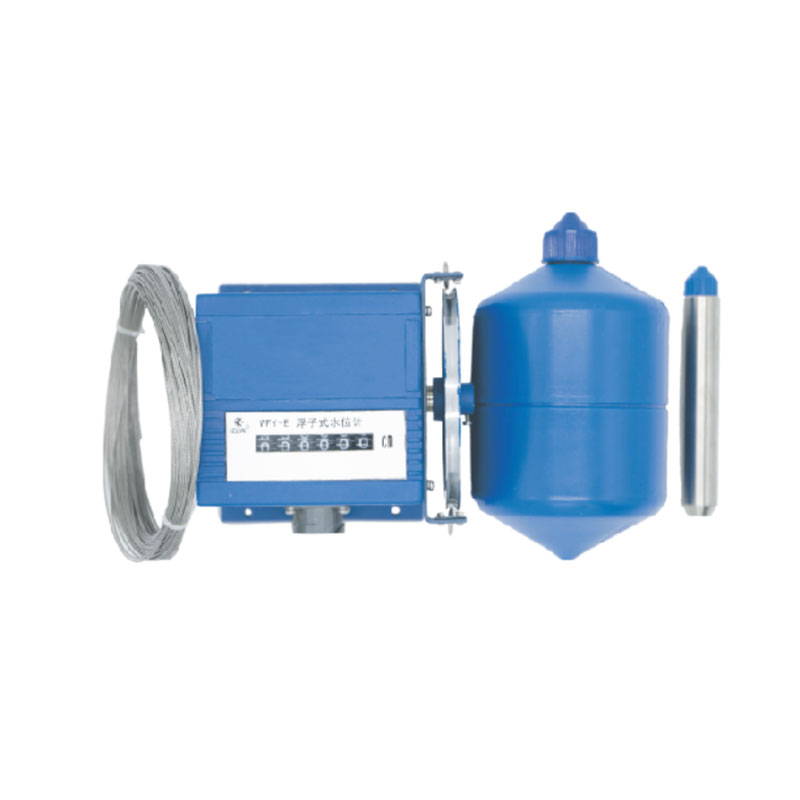Meteorological environment monitoring equipment supplier
Insist on doing high-precision customer favorite technology products

1.Product introduction of float water level meter
The float water level gauge is a digital sensor that integrates mechanical and electrical technology. By converting the angular displacement of the output shaft into a corresponding digital quantity, the measured liquid level can be measured with high precision and the absolute position can be confirmed. It has power-off memory function.
Its working principle is: the water level sensor measuring wheel is installed on the encoder input shaft, one end of the wire rope is connected to the float, the other end is connected to the weight, and the steel wire rope is wound around the measuring wheel. When the liquid level changes, the float rises and falls with the change of the liquid level, the wire rope drives the measuring wheel to rotate, and the encoder outputs the corresponding real-time water level value.
The sensor has a reasonable structure, strong anti-interference ability, high resolution, large measuring range, long life, and has a signal tracking and memory function after power failure. It can be used for liquid level measurement for a long time and ensures stable and reliable performance.
It is widely used for water level measurement of surface water or groundwater in rivers, lakes, reservoirs, ship locks, reservoirs, hydropower stations, hydrological stations, water plants, and petrochemical industries.
2. Technical parameters of float water level gauge
1. Basic parameters
Measuring range: 0-5, 10, 20, 40, 80 meters as required;
Water level variability: <100cm/min
Resolution: 1cm
Water level wheel starting torque: <100 g·cm (0.0098N·m)
Measurement accuracy: ≤±2cm or 0.2%F·S
Display: Decimal mechanical counter
2. Mechanical parameters
Working circumference of water level wheel: 32cm
Measuring cable: Φ0.8mm plastic-coated stainless steel cable
Float diameter: 10cm
3. Electrical parameters
Output form: contact on-off output contact resistance: ≤0.5Ω; insulation resistance: ≥10MΩ
4. Communication interface (optional)
RS485 interface (MODBUS-RTU protocol);
Gray code output; 4-20mA current analog output;
5. Usage environment
Ambient temperature: -25℃~85℃
Relative humidity; <95% (40℃)
Dimensions: 132×132×115
Reliability index: MTBF≥25,000 hours under normal instrument maintenance conditions
Power supply voltage: 12-24VDC (gray code output is not used)
3. Working principle of float water level gauge
Instrument structure and working principle:
This instrument consists of a float, wire rope, weight, measuring wheel, sensor, bracket, output socket and other parts.
The working principle is: the instrument uses a float to sense changes in water level. In the working state, the float, weight and wire rope are firmly connected, and the wire rope is suspended in the "V" shaped groove of the water level wheel. The counterweight plays a role in tightening the wire rope and balancing it. Adjusting the counterweight of the float can make the float work on the normal waterline. When the water level remains constant, the forces on both sides of the float and the counterweight are balanced. When the water level rises, the float generates upward buoyancy, causing the counterweight to pull the wire rope to drive the water level wheel to rotate clockwise, and the water level sensor's display reading increases; when the water level drops, the float sinks, pulling the wire rope to drive the water level wheel to rotate counterclockwise, and the water level The sensor's display reading decreases.
The measuring circle circumference of the water level wheel of the mechanical water level sensor in this series of instruments is 32 cm, and the water level wheel and the sensor are coaxially connected. Every time the water level wheel rotates once, the sensor also rotates once, and outputs the corresponding 32 sets of digital codes. When the water level rises or falls, the axis of the sensor rotates at a certain angle, and the sensor synchronously outputs a corresponding set of digital codes (binary cyclic code, also known as Gray code). Instruments with different ranges can output 1024 to 8192 different sets of codes and can be used to measure water level amplitudes from 10 to 80 meters.
Through the multi-core cable connected to the instrument socket, the encoded signal can be transmitted to the electrical display or computer in the observation room for observation, recording or data processing; the water level meter installed with the RS485 digital communication interface can be directly connected to the communication machine , computers are connected to form an automatic hydrological measurement and reporting system and a hydrological satellite telemetry system.
The built-in RS485 digital communication interface (optional) of the instrument has address selection and gating functions. It can transmit information over long distances in a two-wire system. It can drive or receive 31 water levels (or gates) on a pair of twisted pair signal lines. bit) sensor to realize telemetry networking.